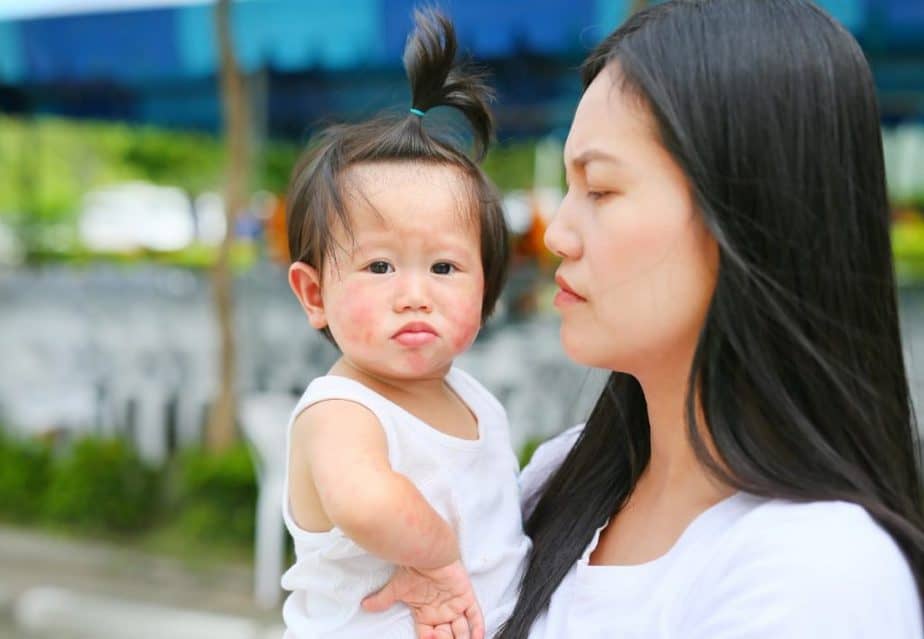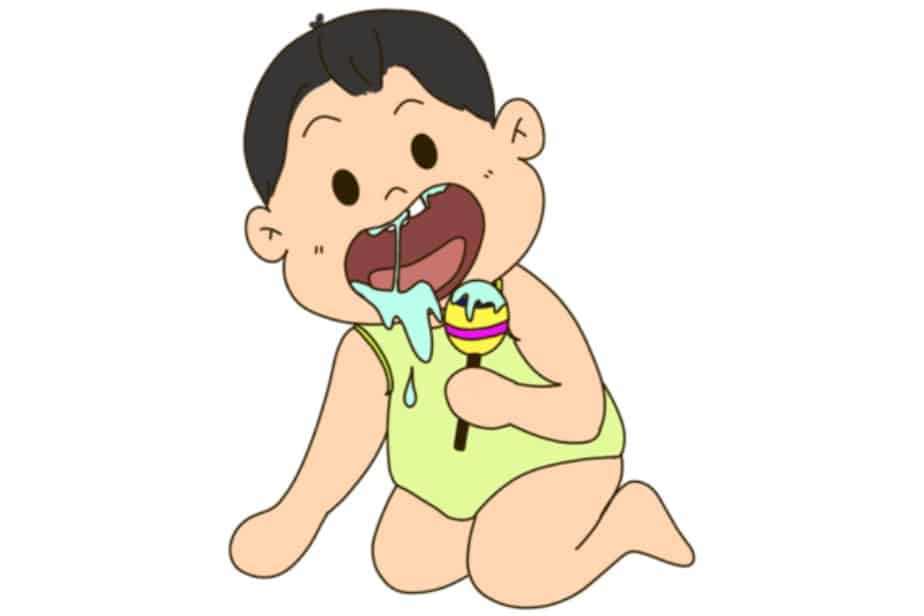When my baby was around 4 months old, he started to drool quite a bit. We didn’t give it much thought since babies drool all the time, but when it didn’t stop after many months, we got a bit worried. Why is he drooling so much? Is anything wrong? The biggest worry for us is whether he is autistic or has down syndrome. We seek his pediatrician for advice, did some research on the internet and got our answer!
So why does my baby drool so much? One of the leading causes of drooling for babies is teething. Babies can start teething from 2 months old and continue until they are 36 months old. Teething stimulates our baby’s mouth to produce more saliva, and because they don’t know how to swallow the saliva, they start to drool.
Now that we know the reason he is drooling, what can we do about it? At which stage do you need to take action? Let’s find out.
How Can I Stop My Baby From Drooling?
You can’t, but there are a few practical steps you can do to reduce drooling.
- Train him to use a straw for drinking – Buy cups that use straws, or give them short straws to drink from. Using straws will increase your baby’s oral strength and encourage them to swallow, as time goes by they will start swallowing their saliva and reduce drooling. If you’re using sippy cups, consider changing to cups with a straw. It’s fine if you change between both types of cups during the day. If your baby doesn’t know how to drink from the straw, use a soft cup and gently press the cup so that the water flows upwards through the straw. When your baby realizes there’s water there he will learn how to drink from it. If he is already on solids, you can use noodles. Put the tip of the noodle into his mouth, and eventually, he will learn how to suck the noodle into his mouth. From then on he shouldn’t have any problems drinking with the straw.
- Limit or take away the pacifier – Pacifiers cause an increase in saliva production, which causes more drooling. If your baby is used to pacifiers, she may not swallow when there’s no pacifier which can cause her to drool more when not using it. We personally don’t use it, and our baby is fine. Yes, it is quite a nice soother, but since it can cause his teeth to misalign, we decided not to use it.
- Use teething rings – You can help to reduce drooling by temporarily relieving his teething discomfort. Put the teething ring in the refrigerator before use, cold teething rings can reduce discomfort. Don’t put it in the freezer though, you may injure your baby. Just normal cold will do.
- Massage his gums – We use our finger to clean his gums and teeth. While cleaning this way, you can gently massage the gums. It helps to reduce the soreness during teething, and can temporarily reduce drooling. This is also a good way to develop his mouth muscles, with strong mouth muscles he can swallow easier, thus less drool! Don’t directly use your fingers though, your fingers don’t have enough grip to clean and massage properly, and sharp nails may injure your baby. Use a finger toothbrush or wrap a clean cloth around your fingers. Here’s an Amazon link to a finger toothbrush.
- Use an electric toothbrush – If you prefer, an Electric toothbrush is another popular way to clean his gums and teeth, it stimulates the mouth and increases its sensitivity. Use it on his teeth, tongue, and gums. You may want to wait until the teething period is over before trying this as your baby may not like it.
How To Handle Drool Rash?

If there is a lot of drooling and it is not handled accordingly, your baby can start to develop drool rash and can even smell bad. The thing about drool rashes is you may not even realize your baby has it because it can be hidden beneath his skin folds. Babies tend to be chubby and short, so when bathing him you need to check the neck folds, chin folds, chest folds and clean them thoroughly. Apply soap on your hands and slide into these areas to thoroughly clean it without causing friction and reduce irritation to your baby’s tender skin. To clean after washing, take a cloth to dab on the areas, try not to rub as it will irritate the already affected skin. Drool rashes will go away when the affected areas are kept clean. I personally don’t like to apply lotions as it may become another source of dirt later on, but if the rashes don’t go away, consult your pediatrician about it.
After you have cleaned the affected areas, start using a bib. It’s an excellent way to prevent drool and even vomit from flowing to the skin folds. I prefer to use cotton bibs as they are cooler. Don’t use bibs when your baby is sleeping, if it ends up covering his face it can cause suffocation. I’ve written another article here with more info on how to take care of hidden dirt, check it out, especially if your baby smells bad as well.
Is Drooling A Sign Of Autism?
Yes, but you should only be alarmed when your baby is drooling after 3 years old or he is no longer teething. Drooling is one of the many signs of autism, and if you’re worried about autism, you should check out the other autism symptoms or seek professional advice, if it’s just drooling, it’s likely not autism. I recommend that you monitor your baby’s development, if he is developing according to the development milestones, autism is highly unlikely. I’ve written an article about baby development here. There are different development stages on each stage of your baby’s life, check out the appropriate post based on the link I just provided.
As a first time parent, I was very worried about autism, and any sign from my son that I felt uncomfortable with, I would worry if it’s autism. That’s not a very nice way to watch our child grow up. My wife, on the other hand, being educated in early childhood development was not worried because he has met his development milestones. Be like my wife! Monitor your child’s development milestones to get a peace of mind!
Can Sickness Cause Excessive Drooling?
Yes, under some circumstances, drooling is a sign of sickness or disorder. I’ll list some I came across when doing my research, do consult your baby’s pediatrician if you suspect any of these.
1. Gastroesophageal Reflux Disease (GERD) [source] – GERD is quite common in infants, two-thirds of 4-month-olds have this symptom. Your baby may spit-up liquid mostly made of saliva and stomach acid. If this happens often, consult a pediatrician.
2. Tonsillitis [source] – When your baby has inflamed tonsils, they will have difficulty in swallowing, hence more drool. It is quite rare for this to happen to babies below 2 years old, but if you notice that your baby has difficulty eating or drinking, this may be it, consult a pediatrician.
3. Cerebral Palsy [source] – Cerebral Palsy is the most common cause of motor disability according to the CDC and one of the signs is excessive drooling. It is a type of brain damage that usually occurs before birth, sometimes during birth or the first years of life. Check out the language milestones I wrote for 2-4 months old and 4-6 months old, if your baby meets both language milestones it’s unlikely he has Cerebral Palsy. If you’re really worried, consult a pediatrician.
Related Questions
Why does my baby’s saliva smell bad? Before he starts to take solid food, there’s no smell on his saliva and breath, sounds great! That changes when he starts taking solid food. His saliva and breath will start to smell bad just like any toddler or adult. Brush his gums and teeth at least once a day and he will be fine.
How can I be sure that drooling isn’t a cause for concern? If your baby is developing well according to these developmental milestones, it is highly likely that your baby is growing up well. I mentioned the development milestones a few times in this post because it’s something you can monitor at home by yourself and have a peace of mind to enjoy seeing your baby grow up. If you’re really feeling restless, please bring your baby to a pediatrician for a check-up.

